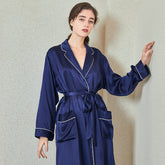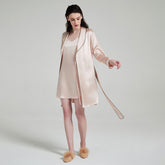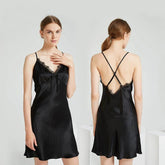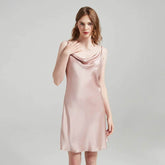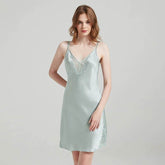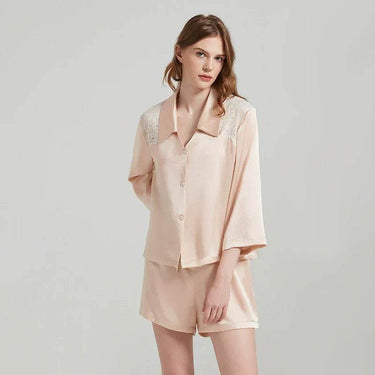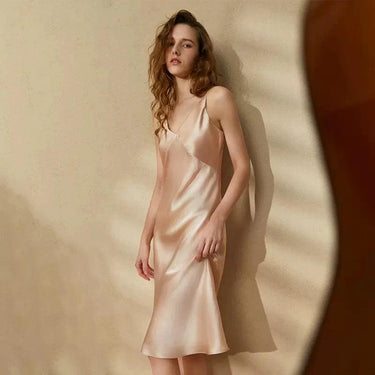Silk Pajamas for Women – Sleep in Pure Luxury & Comfort
Understanding Silk Pajamas: A Gateway to Luxurious Sleep
The pursuit of perfect sleep leads many to discover the unparalleled comfort of silk pajamas, treasured for centuries as the epitome of nighttime luxury. These garments represent more than mere sleepwear—they embody a conscious choice to elevate everyday rest into a restorative ritual. Genuine silk pajamas feature natural protein fibers secreted by silkworms, creating a fabric known for its exceptional smoothness, breathability, and gentle interaction with human skin.
Silk stands apart from other textiles through its unique molecular composition. The protein structure of silk fibers creates a naturally smooth surface that glides across skin without causing friction or irritation. This remarkable material maintains its structural integrity through countless nights while providing consistent comfort that synthetic alternatives struggle to match. The natural luster of silk pajamas also delivers a visual richness that communicates luxury and refinement.
Historically, silk sleepwear traces back to ancient China, where it served as a status symbol among royalty and nobility. The knowledge of silk production remained a closely guarded imperial secret for nearly 3,000 years, making silk one of the most coveted trade commodities along the ancient Silk Road. By the Middle Ages, silk nightwear had become firmly established among European aristocracy as an essential element of luxury living. This rich heritage continues today, with modern silk pajamas marrying traditional craftsmanship with contemporary designs to offer sleepwear that connects wearers to generations of luxury while providing practical benefits for restful sleep.

The Science Behind Silk's Comfort
The extraordinary comfort of silk pajamas stems directly from the molecular structure of silk fibers. Each strand consists of protein molecules arranged in a unique crystalline formation that creates both strength and exceptional softness. This natural architecture yields a fabric with unmatched properties particularly beneficial for sleepwear.
Temperature Regulation Excellence
Silk possesses remarkable thermoregulatory capabilities, adapting to body temperature throughout the night. The structure of silk fibers creates microscopic air pockets that provide insulation in cooler environments while allowing excess heat to escape during warmer periods. This natural temperature adjustment mechanism helps maintain optimal sleep conditions regardless of seasonal changes. Studies show silk can effectively regulate temperature within a 4°F (2.2°C) range, preventing the disruptive sleep cycles caused by overheating or chilling.
Natural Hypoallergenic Protection
The proteins in silk fibers contain 18 amino acids that share similarities with human skin, which contributes to silk's natural hypoallergenic properties. Unlike synthetic fabrics that trap allergens and irritants, silk resists dust mites, mold, and fungus—common triggers for nighttime allergies. Research published in the Journal of Investigative Dermatology confirms that pure silk significantly reduces exposure to allergens compared to cotton and synthetic alternatives. This natural resistance makes silk pajamas particularly valuable for those with sensitive skin or respiratory conditions.
Moisture Management System
Silk effectively wicks moisture away from the body while allowing the skin to breathe naturally. The fiber structure absorbs up to 30% of its weight in moisture without feeling damp to the touch. This capacity helps maintain skin hydration while preventing the uncomfortable clamminess often experienced with synthetic sleepwear. The natural protein structure ensures that excess perspiration moves away from the body, creating a consistently dry and comfortable sleep environment.
Clinically Supported Benefits
Dermatologists increasingly recommend silk pajamas for patients with eczema, psoriasis, and other skin conditions. A clinical study published in the American Academy of Dermatology journal documented reduced symptoms among patients who switched to silk sleepwear for a 12-week period. Participants reported decreased itching, irritation, and improved sleep quality. The friction-reducing properties of silk minimize mechanical stress on sensitive skin, allowing for uninterrupted rest and enhanced recovery during sleep.

Decoding Silk Quality: Momme and Grade
Understanding silk quality requires familiarity with specialized terminology that reflects its unique manufacturing standards. Two primary metrics determine silk quality: momme weight and grade classification. These measurements provide concrete ways to evaluate silk pajamas before purchase.
Momme Weight: The Density Standard
Momme (pronounced "mum-ee") measures silk fabric density and serves as the primary indicator of durability and quality. This metric quantifies the weight in pounds of a piece of silk measuring 45 inches by 100 yards. Higher momme counts indicate denser, more durable silk that typically offers greater longevity and a more luxurious feel. For sleepwear, the optimal range falls between 19-22 momme, balancing durability with the necessary drape and breathability for comfortable sleep.
Silk Grade: The Quality Hierarchy
Silk grades, ranging from 2A to 6A, classify the fabric based on uniformity, coloration, and purity of the fiber. This standardized system evaluates factors including the percentage of pure silk fibers, the consistency of weave, and the presence of any irregularities. The highest classification, 6A, represents the pinnacle of silk quality with impeccable uniformity and exceptional purity. Premium pajamas typically use 5A or 6A grade silk to ensure superior comfort and longevity.
Comparison of Momme Weights and Grades for Pajamas
| Momme Weight | Durability | Feel | Best For | Typical Price Range |
|---|---|---|---|---|
| 12-15 | Low-Medium | Light, Airy | Summer wear, Budget options | $50-120 |
| 16-19 | Medium | Soft, Flowing | Year-round wear, Daily use | $120-250 |
| 19-22 | High | Luxurious, Substantial | Premium pajamas, Gift-quality | $250-400 |
| 22+ | Very High | Heavy, Opulent | Heirloom pieces, Extreme luxury | $400+ |
| Silk Grade | Characteristics | Recommended For |
|---|---|---|
| 3A | Basic quality, Some inconsistencies | Budget options, Occasional wear |
| 4A | Good quality, Minimal irregularities | Mid-range pajamas, Regular use |
| 5A | Premium quality, Consistent texture | Luxury pajamas, Long-term investment |
| 6A | Ultimate quality, Perfect uniformity | Finest sleepwear, Maximum comfort |
For optimal sleeping comfort combined with reasonable longevity, experts recommend selecting silk pajamas with 19-22 momme weight and 5A grade or higher. This combination delivers the perfect balance of luxurious feel, breathability, and durability that justifies the investment in premium sleepwear. Lower momme weights may require more delicate handling and typically show wear more quickly, while exceeding 22 momme might sacrifice some of the natural drape that makes silk pajamas so comfortable.
Types of Silk Used in Pajamas
The world of silk encompasses several distinct varieties, each with unique characteristics that influence their suitability for luxurious sleepwear. Understanding these differences helps consumers make informed choices based on personal preferences and priorities.
Mulberry Silk: The Gold Standard
Mulberry silk, produced by Bombyx mori silkworms fed exclusively on mulberry leaves, represents the highest quality silk available today. These carefully cultivated silkworms create longer, more uniform filaments resulting in exceptionally smooth fabric with minimal irregularities. The protein composition of mulberry silk includes 18 essential amino acids that benefit human skin through direct contact. This premium silk accounts for over 90% of global silk production and serves as the foundation for luxury pajamas that combine comfort with durability.
The natural properties of mulberry silk include temperature regulation that keeps sleepers comfortable in diverse climates, hypoallergenic qualities beneficial for sensitive skin, and a natural resistance to dust mites that supports respiratory health. The consistent fiber structure creates a smooth surface that reduces friction against skin and hair, preventing irritation and bedhead. Premium mulberry silk pajamas typically feature 5A or 6A grade classification with 19-22 momme weight, offering the ideal balance of luxury and longevity.
Alternative Silk Varieties
While mulberry silk dominates the premium sleepwear market, several other silk types offer unique properties:
Tussah Silk (also called wild silk) comes from uncultivated silkworms that feed on oak and juniper leaves. This creates a more textured fabric with natural color variations and a slightly coarser feel. Tussah silk offers excellent durability and often appeals to those seeking more rustic, natural aesthetics in their sleepwear.
Eri Silk, known as "peace silk," allows the silkworm to complete its lifecycle before harvesting the cocoon. This ethical production method yields a silk with wool-like texture and exceptional thermal properties, making it particularly suitable for cooler climates.
Muga Silk, primarily produced in Assam, India, features distinctive golden coloration and exceptional durability. This rare variety offers antimicrobial properties beyond standard silks but comes with a significantly higher price point reflective of its scarcity.
Silk Type Comparison for Sleepwear
| Silk Type | Pros | Cons | Best For |
|---|---|---|---|
| Mulberry Silk | Exceptionally smooth, Hypoallergenic, Temperature-regulating, Long-lasting | Higher price point, Requires careful maintenance | Luxury sleepwear, Sensitive skin, Year-round comfort |
| Tussah Silk | Natural variations add character, More durable, Often less expensive | Slightly rougher texture, Less consistent appearance | Casual sleepwear, Those seeking natural aesthetics |
| Eri Silk | Ethical production, Superior insulation, Unique texture | Limited availability, Less traditional "silk feel" | Cold-weather pajamas, Ethical consumers |
| Muga Silk | Distinctive gold color, Exceptional durability, Antimicrobial properties | Very expensive, Limited production | Collector pieces, Ultimate luxury, Special occasions |
For those seeking the optimal combination of comfort, skin benefits, and longevity in everyday sleepwear, mulberry silk stands as the recommended choice. Its consistent quality, proven benefits for skin and hair health, and established care protocols make it the preferred option for premium pajamas. However, those with specific ethical concerns or aesthetic preferences might find satisfaction in exploring alternative silk varieties that align with their particular values and needs.

Popular Styles of Women's Silk Pajamas
The world of women's silk pajamas offers diverse silhouettes designed to enhance comfort while delivering distinct aesthetic experiences. Each style provides specific benefits that address various sleeping preferences, body types, and lifestyle considerations.
Classic Pajama Sets: Timeless Elegance
The traditional two-piece pajama set features a button-down top with a notched collar and matching pants with an elastic or drawstring waist. This enduring design combines sophisticated styling with practical comfort, making it appropriate for both sleeping and casual lounging. The straight-cut silhouette allows unrestricted movement during sleep while maintaining an elegant appearance. Classic sets typically feature piping details that emphasize the luxurious construction and contribute to their timeless appeal.
Image description: A woman wearing a rich navy blue silk pajama set with white piping detail, showcasing the classic cut with comfortable drape and elegant finish.
Camisole and Shorts Sets: Warm Weather Comfort
For warmer climates or summer nights, camisole and shorts combinations provide maximum breathability while maintaining silk's natural cooling properties. The sleeveless design reduces fabric contact with the skin, allowing optimal air circulation. These sets typically feature adjustable straps for personalized fit and lace or silk trim details that enhance their feminine aesthetic. The shorter length makes them particularly suitable for warmer sleepers who prioritize temperature regulation.
Image description: A blush pink silk camisole and shorts set with delicate lace trim, demonstrating the lightweight and breathable nature of this warm-weather sleep solution.
Slip Dresses: Streamlined Simplicity
Silk sleep dresses combine elegant simplicity with unrestricted movement through their flowing silhouette. These one-piece designs eliminate the potential discomfort of waistbands during sleep while providing full coverage with minimal fabric contact. Slip dresses range from mid-thigh to ankle length, with adjustable straps allowing for personalized fit. The clean lines and minimal seams make this style particularly comfortable for those who dislike clothing restrictions during sleep.
Image description: An emerald green floor-length silk sleep dress with subtle side slits, highlighting the fluid drape and uninterrupted silhouette that allows freedom of movement.
Kimono-Style Robes and Pajamas
Drawing inspiration from traditional Japanese garments, kimono-style pajamas feature wider sleeves and overlapping front panels that create an elegant silhouette. This style often incorporates decorative elements such as embroidery or printed patterns that enhance its visual appeal. The looser fit accommodates various body types while providing excellent air circulation. Many kimono sets include matching robes that complete the ensemble for lounging beyond the bedroom.
Image description: A floral printed silk kimono pajama set with coordinating robe, featuring wide sleeves and an elegant wrap design that flatters multiple body types.
Mix-and-Match Separates: Versatile Solutions
Contemporary silk pajama collections increasingly offer separate pieces designed for interchangeability. This approach allows for personalized combinations based on seasonal needs or individual preferences. Common options include long and short-sleeved tops, pants in various lengths, shorts, and adaptable layers like bed jackets or lightweight robes. The versatility of separates creates wardrobe efficiency while addressing specific comfort requirements.
Image description: A collection of silk pajama separates in complementary jewel tones, showing how different pieces can be mixed to create personalized sleep ensembles.
Caring for Your Silk Pajamas
Proper maintenance extends the lifespan of silk pajamas while preserving their luxurious feel and appearance. Following specific care routines protects your investment and ensures continued enjoyment of silk's natural benefits.
Washing Methods That Preserve Fiber Integrity
Hand Washing: The Safest Approach
- Fill a clean basin with lukewarm water (85°F/30°C)
- Add a specialized silk detergent or gentle shampoo (1 teaspoon per gallon/4 liters)
- Submerge silk pajamas and gently agitate for 2-3 minutes
- Avoid rubbing, twisting, or scrubbing motions that damage fibers
- Rinse thoroughly with cool water until no soap residue remains
- Press gently between clean towels to remove excess moisture
Machine Washing: Cautious Convenience
- Use a mesh laundry bag to prevent snags and reduce friction
- Select cold water setting (below 86°F/30°C)
- Choose delicate cycle with minimal agitation
- Use silk-specific or enzyme-free detergent in reduced amounts
- Avoid fabric softeners that leave residue on natural fibers
- Remove promptly after cycle completes to prevent wrinkles
Drying Techniques That Maintain Shape and Texture
The proper drying method significantly impacts silk longevity. Never wring silk pajamas, as this damages the fiber structure. Instead:
- Lay flat on a clean, dry white towel
- Reshape garment to original dimensions while damp
- Avoid direct sunlight which fades colors and weakens fibers
- Position away from heat sources that can dry fibers too quickly
- Allow complete air drying before storing (typically 8-12 hours)
For minor wrinkles, steaming provides gentler rejuvenation than ironing. If ironing becomes necessary, use the lowest silk setting with a pressing cloth between the iron and fabric.
Strategic Storage Solutions
- Ensure silk is completely dry before storing to prevent mildew
- Choose breathable containers like cotton garment bags
- Avoid plastic which traps moisture and prevents air circulation
- Store folded rather than hung to prevent stretching
- Add cedar blocks rather than mothballs to deter pests
- Protect from prolonged exposure to direct sunlight
Addressing Common Stains
| Stain Type | Treatment Method |
|---|---|
| Oil-based (makeup, lotion) | Apply talcum powder to absorb oil, brush away after 12 hours, follow with normal wash |
| Water-based (juice, wine) | Blot immediately with absorbent cloth, rinse with cold water, wash normally |
| Perspiration | Mix equal parts white vinegar and water, dab gently, rinse thoroughly |
| Deodorant | Create paste with baking soda and water, apply gently, rinse completely |
Common Mistakes to Avoid
- Using bleach or products containing optical brighteners
- Applying spot treatments without testing on hidden areas first
- Exposing wet silk to extreme temperature changes
- Storing before completely dry
- Using standard detergents containing enzymes that damage protein fibers
With proper care, high-quality silk pajamas maintain their exceptional properties for 5-10 years of regular use. This longevity makes them a practical investment in sleep quality, despite their higher initial cost compared to synthetic alternatives.
The Best Silk Pajamas for Different Body Types
Silk pajamas enhance their luxurious qualities when properly fitted to individual body proportions. Strategic silhouette selection creates flattering lines while maximizing comfort during sleep.
Petite Frames (5'4"/162cm and under)
Women with smaller statures benefit from proportionally scaled designs that avoid overwhelming their frames. Look for:
- Higher hemlines (mid-thigh to knee length) that create vertical lines
- Narrower leg widths that maintain proportion
- Shorter inseams (26-28 inches/66-71cm) that eliminate pooling fabric
- Defined waistlines that provide shape definition
- Smaller patterns or solid colors that don't overwhelm
LANI SILK offers petite-specific sizing with recalibrated proportions rather than simply shortened standard cuts. These specialized dimensions maintain proper shoulder alignment, appropriate armhole depth, and balanced design elements. The Classic Petite Collection features pants with 26-inch (66cm) inseams and appropriately scaled tops that enhance rather than overwhelm smaller frames.
Curvy and Plus-Size Proportions
For fuller figures, silk pajamas should provide comfort without sacrificing style or beneficial properties:
- Look for elastic waistbands with substantial recovery properties
- Choose generously cut armholes for unrestricted movement
- Select styles with bust darts for improved draping
- Opt for strategic seam placement that enhances natural contours
- Consider semi-fitted styles rather than extremely loose or tight cuts
Premium silk's natural stretch accommodates curves without compression, allowing the fabric to drape elegantly over different body shapes. The LANI SILK Curve Collection extends to size 3X with proportionally adjusted dimensions rather than simply enlarged standard patterns. These designs feature reinforced seams, wider straps, and strategically positioned panels that provide both comfort and flattering silhouettes.
Tall Proportions (5'9"/175cm and above)
Women with longer frames require extended dimensions that accommodate height while maintaining elegant drape:
- Seek longer inseams (32-34 inches/81-86cm) that reach appropriate points
- Choose tops with sufficient torso length to prevent riding up
- Look for sleeve lengths that reach proper wrist position
- Consider kimono styles that traditionally feature generous proportions
- Select vertical patterns that complement height
The LANI SILK Tall Collection features extended inseams, longer shirt tails, and appropriately positioned waistbands that accommodate longer torsos. These proportional adjustments ensure tall women experience the full benefits of silk pajamas without compromise.
Universal Fit Considerations
Regardless of body type, certain fitting principles apply to all silk pajamas:
- Shoulder seams should align with natural shoulder edges
- Sleeves should end at natural wrist bones without pulling
- Pant legs should move freely without binding at thighs
- Waistbands should sit comfortably without rolling or digging
- Fabric should skim rather than cling to the body's contours
Premium silk pajamas feature proper ease allowances that facilitate movement during sleep while maintaining elegant draping properties. The natural elasticity of silk allows for comfort across body types while preserving the fabric's beneficial properties.
Seasonal Considerations for Silk Pajamas
Silk's natural properties make it suitable for year-round sleep comfort, with strategic adjustments allowing adaptation to seasonal temperature variations. Understanding these seasonal modifications helps maximize silk's natural benefits throughout changing weather patterns.
Summer Silk: Embracing Natural Cooling
During warmer months, silk pajamas leverage the fabric's natural temperature regulation capabilities through specific design elements:
- Lightweight construction (12-16 momme) maximizes breathability
- Shorter sleeves or sleeveless designs reduce fabric coverage
- Higher hemlines allow greater air circulation
- Looser fits minimize direct skin contact
- Lighter colors reflect rather than absorb heat
Hot weather silk pajamas often feature wider armholes, relaxed necklines, and minimal seaming that prevents heat retention. The natural moisture-wicking properties become particularly valuable during summer months, drawing perspiration away from the skin to maintain comfortable sleep temperatures. For optimal summer comfort, look for silk pajamas weighing 14-16 momme, which provide the ideal balance of durability and breathability.
Summer Silk Checklist:
- Momme weight: 12-16
- Style: Camisoles, shorts, slip dresses
- Colors: Lighter shades that reflect heat
- Fit: Looser styles with minimal restriction
Winter Silk: Insulation Without Bulk
Cold weather adaptations leverage silk's natural insulating properties while maintaining breathability:
- Higher momme weights (19-22) provide additional warmth
- Long sleeves and pants create full coverage
- Layered pieces offer adjustable insulation
- Closer fits retain body heat efficiently
- Darker colors absorb and maintain warmth
Winter silk sets often feature lined options or double-layer construction that enhances insulation without adding significant weight. The protein structure of silk creates microscopic air pockets that trap body heat in cold environments while still allowing excess moisture to escape. This natural temperature regulation prevents the chilling effect caused when perspiration remains against the skin.
Winter Silk Checklist:
- Momme weight: 19-22
- Style: Long pants, long-sleeve tops, lined options
- Colors: Deeper hues that absorb warmth
- Fit: Closer cut styles with sufficient movement allowance
Transitional Season Versatility
Spring and fall require adaptable sleep solutions that address fluctuating temperatures:
- Mid-range momme weights (16-19) balance insulation and breathability
- Layerable pieces accommodate temperature variations
- Three-quarter sleeves provide adjustable coverage
- Convertible designs offer adaptation options
- Mixed weights (lighter tops with medium-weight bottoms)
LANI SILK's Seasonal Transition Collection features adjustable elements like roll-up sleeves, removable layers, and multi-function pieces that adapt to changing weather patterns. These versatile designs maximize wardrobe efficiency while ensuring consistent sleep comfort.
Transitional Silk Checklist:
- Momme weight: 16-19
- Style: Convertible designs, adjustable elements
- Colors: Mid-tone versatile shades
- Fit: Adaptable with layering capacity
Year-Round Silk Essentials
Certain silk pajama styles serve as foundation pieces across seasons:
- Classic button-up pajama sets in 19 momme weight
- Three-quarter sleeve tops with adjustable cuffs
- Mix-and-match separates for customized combinations
- Lightweight robes that function as layering pieces
- Solid colors that transition seamlessly between seasons
The 19 momme weight represents the optimal balance point for year-round use, providing sufficient durability for regular laundering while maintaining appropriate weight for multi-season comfort. This versatile density allows the natural properties of silk to function effectively across temperature ranges while providing excellent value through extended wearability.
Investing in Silk Pajamas: Price vs. Quality
The significant price variation among silk pajamas reflects substantial differences in material quality, production methods, and expected longevity. Understanding these distinctions helps consumers make informed investment decisions based on personal priorities and budget considerations.
Budget Range ($50-$120)
Entry-level silk pajamas typically feature:
- Lower momme weights (12-15) requiring more delicate handling
- Mixed silk content (often blended with synthetic fibers)
- Mass production techniques with less attention to finish details
- Limited size ranges with standard dimensions
- Basic construction with minimal reinforcement
- Machine-finished edges with potential durability concerns
- Shorter expected lifespan (1-2 years with regular use)
These options provide an introduction to silk's benefits but may not deliver the full range of advantages associated with premium silk. Construction techniques often prioritize cost-efficiency over longevity, requiring more careful maintenance to extend usable life.
Mid-Range Options ($120-$250)
Mid-tier silk pajamas typically offer:
- Improved momme weights (16-19) balancing durability with price
- Higher silk content (usually 90-95% pure silk)
- Better construction techniques with reinforced stress points
- Expanded size options with limited specialized proportions
- Enhanced finishing details like French seams
- More refined color and pattern options
- Moderate lifespan (2-4 years with proper care)
This category represents a substantial quality improvement over budget options while remaining accessible to many consumers. The higher silk content delivers more of the natural benefits associated with the material, while improved construction techniques enhance overall durability.
Luxury Segment ($250-$400)
Premium silk pajamas feature:
- Optimal momme weights (19-22) for ideal drape and longevity
- 100% pure mulberry silk with 5A or 6A grade classification
- Specialized construction techniques like hand-rolled hems
- Extended size ranges with proportionally adjusted dimensions
- Reinforced stress points and high-quality closures
- Superior color consistency and finish quality
- Substantial expected lifespan (5-10 years with proper care)
LANI SILK positions its collections within this premium category, emphasizing true investment value through superior materials and construction. The enhanced durability provides substantial cost-per-wear advantages despite higher initial investment, with proper care extending usable life beyond five years of regular use.
Ultra-Luxury Market ($400+)
The highest tier offers:
- Exceptional momme weights (22+) for maximum durability
- Rare silk varieties or specialized weaving techniques
- Couture-level construction with substantial hand-finishing
- Custom sizing options and bespoke details
- Collector-quality production with limited distribution
- Heirloom potential with proper maintenance
- Lifetime warranties with specialized repair services
These options represent the pinnacle of silk sleepwear, with prices reflecting both material quality and labor-intensive production methods. The investment value derives from exceptional longevity and unique characteristics rather than practical cost-per-wear calculations.
Finding Quality Within Budget Constraints
For consumers seeking maximum value, strategic shopping approaches help identify quality options across price ranges:
- Prioritize higher momme weight over design complexity
- Look for sales on previous season collections from premium brands
- Consider classic styles that maintain relevance beyond trend cycles
- Invest in separates strategically, focusing on pieces with greatest skin contact
- Evaluate cost-per-wear based on expected lifespan with proper care
A single high-quality silk pajama set often provides greater value than multiple budget options through extended lifespan and superior performance. The practical benefits of premium silk—enhanced sleep quality, improved skin health, and reduced hair damage—contribute additional value beyond the garment's physical longevity.
Styling Silk Pajamas Beyond the Bedroom
The evolution of contemporary fashion has blurred traditional boundaries between sleepwear and daywear, with silk pajamas increasingly appearing beyond bedroom contexts. This versatility enhances their investment value while providing sophisticated styling options for various settings.
Casual Daytime Transitions
The silk pajama top emerges as a versatile separate that pairs effectively with structured daywear:
- Style with slim-fit jeans for balanced proportions
- Add structured blazers to formalize the silhouette
- Layer under oversized cardigans for textural contrast
- Pair with tailored shorts for warm-weather sophistication
- Complete with minimal leather accessories for refined casualness
The intrinsic elegance of silk elevates these casual combinations beyond ordinary daywear, creating distinctive ensembles that convey both comfort and intentional styling. The subtle luster of high-quality silk adds dimensional interest to otherwise simple outfits.
Elevated Evening Options
For evening settings, complete silk pajama sets offer unexpected sophistication:
- Replace traditional pants with silk pajama trousers for dinner events
- Add architectural jewelry to elevate the entire ensemble
- Layer structured coats over pajama sets for formal contrast
- Substitute conventional evening wear with full silk sets for home entertaining
- Incorporate silk robes as dramatic outerwear for artistic settings
These approaches create distinctive aesthetics that reference loungewear while transcending its limitations through strategic styling choices. The flowing drape of silk pajama pants provides an elegant alternative to conventional evening wear while maintaining comfort throughout extended social engagements.
Workplace Adaptations
Even professional environments accommodate certain silk pajama elements when properly styled:
- Pair silk pajama shirts with tailored skirts for office-appropriate combinations
- Layer structured blazers over silk tops to maintain professional boundaries
- Select subtle colors and patterns that align with workplace aesthetics
- Choose higher momme weights that maintain structure throughout the day
- Complement with refined accessories that emphasize intentional styling
These professional adaptations require selective incorporation rather than complete pajama sets, with structure and proportion creating appropriate balance for workplace contexts. The luxurious feel of silk provides day-long comfort while projecting polished professionalism.
Etiquette Considerations
While fashion boundaries continue evolving, certain guidelines help determine appropriate contexts for pajama-inspired styling:
- Avoid designs with obvious sleepwear details like contrast piping in formal settings
- Select pieces that maintain structure rather than relaxed silhouettes for public wear
- Ensure fabrics have sufficient weight (19+ momme) to prevent transparency issues
- Pay special attention to proper fit when adapting sleepwear for public settings
- Balance relaxed pajama elements with structured pieces for intentional contrast
The thoughtful adaptation of silk pajamas into diverse wardrobe contexts maximizes their versatility while respecting contextual appropriateness. This expanded functionality creates additional value beyond their primary sleep function, enhancing their overall investment proposition.
The Environmental Impact of Silk Production
Silk production presents complex environmental considerations that influence purchasing decisions for environmentally conscious consumers. Understanding the full ecological context helps identify responsible options within the luxury sleepwear market.
Traditional Silk Production Methods
Conventional silk manufacturing follows production systems established over centuries:
Silkworms (Bombyx mori) consume significant quantities of mulberry leaves during their growth cycle, with approximately 100 pounds (45 kg) of leaves required to produce one pound (0.45 kg) of raw silk. Cultivation typically occurs on specialized farms, often using traditional agricultural methods with varying degrees of chemical input.
The harvesting process traditionally involves sacrificing silkworms by exposing cocoons to heat, preventing moths from breaking silk filaments upon emergence. This method produces long, continuous fibers ideal for high-quality textiles but raises ethical concerns among some consumers.
Processing requires substantial water usage for degumming cocoons, removing the natural sericin protein that binds silk filaments. Traditional methods employ boiling water with alkaline substances to dissolve this binding agent, creating wastewater that requires proper management.
Dyeing processes introduce additional environmental considerations, with conventional techniques utilizing chemical colorants that can impact water systems if improperly managed. The intensity of these impacts varies significantly based on production facility standards and environmental regulations.
Environmental Considerations
The ecological footprint of silk production includes several key factors:
Water Consumption: Conventional silk processing requires 1,500-2,500 gallons (5,700-9,500 liters) of water per pound (0.45 kg) of finished silk—less than cotton but more than synthetic alternatives.
Energy Usage: Traditional production methods involve heating water for various processes, creating energy demands that vary based on facility efficiency and energy sources.
Chemical Applications: Conventional silk production may involve pesticides in mulberry cultivation and chemical agents in processing, though impacts vary widely across production facilities.
Land Requirements: Mulberry cultivation demands dedicated agricultural space, though these trees often grow in areas less suitable for food production.
Carbon Footprint: Transportation impacts vary significantly based on production location and distribution methods, with locally produced silk offering reduced transportation emissions.
Sustainable Silk Alternatives
The market increasingly offers more environmentally conscious options:
Peace Silk (Ahimsa Silk) allows silkworms to complete their lifecycle, emerging naturally from cocoons before silk harvesting. This approach produces shorter fibers requiring different processing techniques but addresses ethical concerns regarding silkworm welfare.
Organic Silk comes from silkworms fed mulberry leaves grown without synthetic pesticides or fertilizers, reducing chemical inputs throughout the production chain. Certified organic options verify compliance with specific agricultural standards.
Recycled Silk repurposes existing silk fabrics, extending material lifespan while reducing demand for new production. These options often blend recovered silk with other fibers to create viable textiles.
Regenerative Silk Production incorporates mulberry cultivation into regenerative agricultural systems that enhance soil health and carbon sequestration while producing silk as a value-added product.
Certifications for Conscious Consumers
Several standards help identify more sustainable silk options:
Global Organic Textile Standard (GOTS) certifies organic cultivation practices and responsible processing methods, including wastewater treatment and restricted chemical usage.
OEKO-TEX Standard 100 verifies finished textiles contain no harmful substances, ensuring product safety while indirectly encouraging cleaner production methods.
Bluesign System certifies responsible resource usage and reduced environmental impact throughout textile production processes.
Regenerative Organic Certified (ROC) identifies agricultural systems that restore soil health while producing fiber crops like mulberry for silkworms.
LANI SILK incorporates sustainability through careful supplier selection, prioritizing production facilities with water recycling systems, energy-efficient technologies, and responsible waste management practices. The company's focus on durable, high-quality silk pajamas that last years rather than seasons also contributes to reduced consumption patterns that benefit environmental objectives.
Silk Alternatives: Comparing Comfort and Luxury
While pure silk represents the pinnacle of luxury sleepwear, several alternatives offer varying combinations of comfort, performance, and affordability. Understanding these options helps consumers evaluate alternatives based on specific priorities.
Silk vs. Satin: Clarifying Common Confusion
The terms "silk" and "satin" often cause consumer confusion, as they represent different classifications:
| Feature | Pure Silk | Polyester Satin |
|---|---|---|
| Composition | Natural protein fiber from silkworms | Synthetic petroleum-based fiber woven in satin structure |
| Feel | Soft, breathable with temperature-regulating properties | Slippery, less breathable, may cause overheating |
| Moisture Management | Absorbs up to 30% of weight in moisture | Repels moisture, creating potential discomfort |
| Skin Benefits | Hypoallergenic, reduces friction, supports skin health | Limited skin benefits, may cause irritation for sensitive skin |
| Durability | Moderate to high with proper care | High resistance to wear, minimal special care required |
| Environmental Impact | Biodegradable, renewable resource | Non-biodegradable, petroleum-derived product |
| Price Range | $80-400+ for genuine silk sleepwear | $20-100 for polyester satin sleepwear |
This fundamental distinction highlights that "silk" refers to the natural fiber itself, while "satin" describes a specific weaving technique that creates a smooth, glossy surface. While pure silk can be woven in a satin pattern (creating silk satin), most budget "silk" pajamas actually contain polyester satin—a synthetic material that mimics silk's appearance without providing its natural benefits.
Modal: The Semi-Natural Contender
Derived from beech tree cellulose, modal offers several properties that position it as a silk alternative:
Advantages:
- Exceptionally soft feel that rivals silk in perceived luxury
- Superior breathability compared to synthetic options
- Excellent moisture-wicking capabilities for dry sleeping comfort
- Natural fiber base with environmentally improved processing
- Significant durability with resistance to shrinkage and fading
- Lower price point ($50-150 for quality modal pajamas)
Limitations:
- Lacks silk's temperature-regulating capabilities
- Doesn't offer the same hypoallergenic benefits for skin
- Creates more static electricity than natural silk
- May pill over time with repeated washing
Modal pajamas provide a practical alternative for consumers seeking natural fiber benefits at more accessible price points. The material delivers substantial comfort and breathability while offering improved durability compared to pure silk. For those with active sleeping patterns or less concern about temperature regulation, modal presents a practical compromise.
Bamboo Lyocell: The Eco-Conscious Choice
Bamboo-derived textiles have gained popularity as sustainable luxury options:
Advantages:
- Exceptionally soft texture comparable to premium silk
- Strong moisture-wicking capabilities for comfortable sleep
- Naturally antibacterial properties resist odor development
- Renewable resource with reduced environmental impact
- Moderate temperature regulation capabilities
- Mid-range pricing ($60-180 for quality bamboo pajamas)
Limitations:
- Processing methods vary in environmental responsibility
- Less durable than silk with potential for faster wear
- Lacks some of silk's natural hair and skin benefits
- Requires careful washing to maintain quality
Bamboo lyocell (distinct from bamboo rayon) offers environmentally conscious consumers a silk alternative with reduced ecological impact. The material provides substantial comfort and moisture management while delivering temperature regulation capabilities that exceed most synthetic options. For those prioritizing sustainability alongside comfort, bamboo presents a compelling compromise in the luxury sleepwear category.
Choosing Based on Personal Priorities
| Priority | Recommended Material | Explanation |
|---|---|---|
| Ultimate Luxury | 100% Mulberry Silk | Unmatched comfort, temperature regulation, and skin benefits justify the investment for those seeking the absolute best sleeping experience |
| Value-Conscious Quality | Modal | Delivers comparable softness and comfort at significantly lower price points, with greater durability for everyday use |
| Sustainable Sleep | Bamboo Lyocell | Provides eco-friendly benefits with comfort characteristics approaching silk, while supporting sustainable resource management |
| Maximum Durability | High-Quality Polyester Satin | Offers longest lifespan with minimal care requirements, though with compromised breathability and temperature regulation |
| Sensitive Skin Solution | 100% Mulberry Silk | The hypoallergenic properties and friction reduction make it unparalleled for those with skin sensitivities despite higher cost |
While alternatives provide certain practical advantages, pure mulberry silk remains the gold standard for luxury sleepwear. The unique combination of natural temperature regulation, hypoallergenic properties, moisture management, and skin health benefits create an unmatched sleeping experience that justifies the premium investment for those seeking optimal rest quality.
Expert Tips for Choosing the Perfect Silk Pajamas
Selecting ideal silk pajamas involves considerations beyond basic size and style preferences. Industry specialists offer insights that help consumers navigate options and identify truly exceptional pieces.
Q: What specific features indicate superior silk pajama quality?
Textile Expert Response: "Examine the seam construction first—French seams or flat-felled seams indicate superior craftsmanship and durability. Next, assess button quality; genuine mother-of-pearl or corozo nut buttons signify premium construction, while plastic buttons suggest cost-cutting. Finally, evaluate fabric consistency by holding against light—premium silk shows uniform thickness without obvious thin spots or irregularities."
Q: How should consumers approach sizing for silk pajamas?
Fashion Consultant Insight: "Silk pajamas should offer 1-2 inches of ease beyond body measurements for optimal comfort during sleep. Unlike daywear, excessively fitted sleepwear restricts movement and reduces comfort. However, excessive fabric creates uncomfortable bunching during sleep position changes. For those between sizes, selecting the larger option generally provides better sleeping comfort while maintaining the elegant drape that makes silk pajamas so appealing."
Q: How does sleep environment influence silk pajama selection?
Sleep Specialist Recommendation: "Consider both bedroom temperature and personal temperature regulation when selecting silk weight. Those sleeping in cooler environments (below 65°F/18°C) benefit from 22 momme weights and longer styles, while warmer sleepers or heated rooms above 72°F/22°C call for lighter 16 momme weights and shorter styles. Additionally, those using multiple blankets should select more breathable designs to prevent overheating, regardless of room temperature."
Q: What colors complement different skin tones best?
Color Analysis Expert: "Warm skin tones with yellow or golden undertones flourish in ivory, champagne, coral, or amber silk that enhances natural radiance. Cool skin tones with pink or blue undertones appear most luminous in silver-gray, lavender, ruby, or sapphire blues that complement their natural clarity. Those with neutral undertones enjoy exceptional versatility but find particular harmony with jade green, navy, or rose tones. Beyond flattery, consider practical factors—lighter colors show oils more readily while deeper colors better conceal potential stains."
Q: What are the most common purchasing mistakes to avoid?
Luxury Retail Specialist: "The primary mistake involves prioritizing initial cost over long-term value. A $250 silk pajama set worn weekly for five years costs approximately $1 per wear—significantly less than replacing $80 sets annually. Second, neglecting to verify fabric composition leads to disappointment; terms like 'silky' often indicate synthetic materials without silk's beneficial properties. Finally, overlooking return policies proves problematic with intimate apparel; ensure the retailer permits exchanges if sizing issues arise, particularly with international sizing."
LANI SILK's design team emphasizes that optimal silk pajama selection balances objective quality metrics with subjective personal preferences. The most technically superior pajamas provide little value if they don't align with individual sleeping habits, style preferences, and comfort requirements. Taking time to evaluate these personal factors alongside quality indicators ensures a satisfying investment in premium sleepwear.
The Psychology of Luxury Sleepwear
The impact of luxury sleepwear extends beyond physical comfort into psychological well-being through multiple mechanisms. Research demonstrates substantive connections between premium sleepwear and measurable psychological benefits.
The Elevated Sleep Ritual
Studies in sleep hygiene highlight the importance of consistent pre-sleep routines that signal the body to prepare for rest. Luxury silk pajamas create a clear transition marker, activating what psychologists term "behavioral anchoring" that conditions the brain to associate specific garments with relaxation. Dr. Michael Breus, clinical psychologist and sleep specialist, notes that "changing into designated sleepwear creates a psychological endpoint to the day and initiates the mental transition toward sleep."
Research published in the Journal of Sleep Research demonstrates that consistent sleep rituals reduce sleep latency (the time required to fall asleep) by an average of 15 minutes compared to inconsistent bedtime approaches. The tactile pleasure of silk against skin enhances this ritual, creating positive associations that strengthen over time through consistent use.
Self-Perception and Sleep Quality
The psychological concept of enclothed cognition—how clothing influences the wearer's psychological processes—applies significantly to sleepwear choices. A Northwestern University study documented that clothing perceived as special or significant triggered measurable changes in behavior and self-perception. Participants wearing items they associated with particular qualities (professional, athletic, luxurious) demonstrated behavioral changes reflecting those qualities.
Applied to silk pajamas, this research suggests wearing garments perceived as luxurious and restorative may enhance relaxation capabilities and promote improved sleep quality. The perception of self-investment and self-care enhances the psychological value of the experience beyond the physical comfort provided by the fabric.
Confidence Through Intentional Choice
Psychologists observe that deliberate self-care practices correlate with improved self-concept and reduced anxiety levels. A 2020 survey conducted among luxury sleepwear consumers found 78% reported "feeling better about themselves" when wearing high-quality sleepwear, even when no one else observed this choice. This private luxury represents what psychologist Dr. Jennifer Baumgartner calls "interior dialogue"—choices made for personal satisfaction rather than external validation.
The intentional selection of premium sleep garments signals self-worth and personal value, countering the cultural tendency to reserve quality and beauty for public display. This private commitment to personal comfort represents a psychological reinforcement of self-care priorities that extends beyond the bedroom into general well-being.
Mind-Body Connection in Sleep Science
Sleep researchers increasingly recognize the interconnection between physical comfort, psychological security, and sleep quality. Dr. Rebecca Robbins of Harvard Medical School notes that "the tactile sense remains active during sleep, influencing both sleep continuity and depth." Her research indicates that comfort disruptions often create micro-arousals—brief awakenings that fragment sleep quality without the sleeper's conscious awareness.
Silk's friction-reducing properties minimize these disruptions, allowing deeper sleep phases to develop without tactile interruption. The psychological comfort of wearing recognized quality further reduces cognitive arousal, facilitating easier transitions between sleep cycles and more restorative rest overall.
The psychological benefits of luxury sleepwear create a self-reinforcing cycle: improved sleep quality enhances mood and cognitive function, which in turn supports better daily performance and reduced stress levels, ultimately contributing to better subsequent sleep. This holistic relationship between premium silk pajamas and psychological well-being establishes their value beyond simple material luxury into practical mental health support.
Frequently Asked Questions About Silk Pajamas
How long should quality silk pajamas last with proper care?
Premium silk pajamas made from 19-22 momme 100% mulberry silk with proper construction should maintain their quality for 5-10 years with regular use and appropriate care. Higher momme weights generally correlate with extended longevity, with 22 momme pajamas often reaching the upper range of this lifespan. The most common failure points include seam breakdown, color fading from improper washing, and fabric thinning in high-friction areas.
Following recommended care protocols significantly extends usable life. Hand washing extends longevity by approximately 30% compared to machine washing, while proper storage away from direct sunlight prevents premature fading and fiber weakening. The investment in proper care supplies—specialized silk detergent, proper storage containers, and gentle handling—typically costs less than $50 annually while potentially adding years to your pajamas' lifespan.
Can silk pajamas help with specific health conditions?
Dermatologists increasingly recommend silk sleepwear for patients with eczema, psoriasis, and sensitive skin conditions due to several beneficial properties. The smooth fiber structure reduces mechanical irritation compared to rougher textiles, while the natural temperature regulation prevents overheating that can trigger flare-ups. Dr. Ava Shamban, board-certified dermatologist, notes that "silk's moisture-wicking properties help maintain optimal skin hydration levels, which supports barrier function in compromised skin."
For those experiencing menopausal night sweats, silk pajamas provide practical management through superior moisture-wicking capabilities compared to cotton or synthetic alternatives. The temperature-regulating properties help prevent the chill that typically follows perspiration episodes. Additionally, silk's hypoallergenic nature benefits those with respiratory sensitivities by resisting dust mite accumulation common in other fabrics.
While silk pajamas shouldn't replace medical treatments, they provide complementary support for various conditions through their unique physical properties. Consultation with healthcare providers remains essential for those with severe conditions, though many practitioners now specifically recommend silk sleepwear as part of comprehensive management approaches.
How do I differentiate real silk from synthetic alternatives?
Several simple tests help identify genuine silk:
Burn Test: When burned (test an inconspicuous thread), real silk produces ash that crumbles easily between fingers, smells like burning hair, and self-extinguishes. Synthetics create plastic-like beads, chemical odors, and continue burning.
Ring Test: Pull genuine silk through a ring of moderate size; despite its apparent delicacy, it compresses completely and passes through due to its unique fiber structure. Synthetic alternatives typically resist this compression.
Touch Test: Rub the fabric between fingers—authentic silk creates a warming sensation due to protein fiber friction, while synthetics remain cool to the touch throughout.
Texture Assessment: Inspect the fabric surface—genuine silk displays subtle variations in sheen when viewed from different angles, while synthetic options show more uniform reflectivity regardless of viewing angle.
Price Evaluation: Be skeptical of bargains—100% mulberry silk of good quality rarely sells below $30-40 per yard of fabric, making complete pajama sets priced below $100 highly unlikely to contain genuine silk of substantial quality.
What makes silk pajamas worth the investment compared to alternatives?
The investment value of silk pajamas derives from multiple factors beyond simple comfort:
Longevity Factor: With proper care, premium silk pajamas last 5-10 years—5-10 times longer than typical synthetic alternatives and 2-3 times longer than quality cotton options. This extended lifespan significantly reduces the cost-per-wear despite higher initial investment.
Health Benefits: The measurable improvements in skin health and hair condition provided by silk contact during sleep contribute value beyond the garment itself. Reduced friction means less hair breakage, fewer sleep creases, and better moisture balance for skin—benefits that would otherwise require specialized products.
Sleep Quality Impact: Research documents improved sleep quality with temperature-regulating sleepwear, with potential productivity and health benefits extending far beyond the bedroom. Better sleep correlates with improved immune function, cognitive performance, and emotional regulation.
Multi-Season Functionality: Unlike specialized seasonal sleepwear, quality silk pajamas function effectively year-round through natural adaptation to body temperature, eliminating the need for separate summer and winter sleep wardrobes.
While the initial investment exceeds alternatives, these combined benefits create substantial value that justifies the premium pricing for those prioritizing sleep quality, skin health, and long-term value.
How do I gift silk pajamas appropriately?
Silk pajamas make thoughtful gifts when selected with consideration:
Size Selection: When uncertain about exact size, select based on general body type rather than specific measurements. Most premium brands offer size exchange programs specifically for gifts, resolving potential fit issues without compromising the gesture.
Color Considerations: Choose universally flattering shades like navy, ivory, or jade rather than highly specific colors that might not align with personal preferences. These versatile options complement various skin tones while maintaining sophisticated appeal.
Style Appropriateness: For recipients where you're uncertain about style preferences, classic pajama sets with modest coverage represent the safest option. Avoid highly revealing styles unless you have specific knowledge of the recipient's preferences.
Personalization Options: Many luxury brands offer monogramming or gift packaging that enhances the presentation without altering the fundamental product. These touches acknowledge the gift's significance while maintaining the recipient's ability to exchange if necessary.
Gift receipts included with premium silk pajamas allow size adjustments while still presenting a complete and thoughtful gift. Many luxury sleepwear brands offer specialized gift services including presentation boxes, personalized notes, and extended exchange periods specifically designed for gifting contexts.
The Future of Silk Pajamas: Innovations and Trends
The tradition-rich world of silk sleepwear continues evolving through technological advancement, changing consumer preferences, and innovative production approaches. These developments expand possibilities while maintaining silk's fundamental luxury appeal.
Technological Advancements in Silk Production
The traditional silk industry increasingly embraces technological innovation:
Silk Protein Infusion incorporates additional beneficial compounds during processing. Laboratory developments allow manufacturers to bond supplementary proteins, vitamins, or plant extracts directly to silk fibers, enhancing their natural properties. This technology enables silk pajamas with amplified hypoallergenic properties, extended moisture control, or added aromatherapy benefits that activate with body heat.
Crease-Resistant Treatments address one of silk's traditional limitations through modified finishing processes. These treatments maintain silk's beneficial properties while reducing its tendency to wrinkle, creating more travel-friendly options that require less maintenance. Unlike earlier chemical approaches, new plant-based formulations preserve silk's biodegradability while improving practical functionality.
Smart Textile Integration introduces monitoring capabilities into luxury sleepwear. Experimental silk blends incorporate conductive fibers that track sleep patterns, body temperature, and movement without sacrificing comfort. These developments aim to gather health data without the discomfort of wearing dedicated tracking devices, potentially allowing precise sleep optimization through passive monitoring.
Emerging Market Trends
Consumer preference evolution drives several significant developments:
Customization Platforms gain prominence through digital manufacturing advances. Emerging brands now offer personalized silk pajamas based on individual measurements, sleep preference data, and design choices. These made-to-order approaches reduce inventory waste while providing precisely tailored solutions for diverse body types and sleeping habits.
Men's Silk Sleepwear expansion reflects growing male interest in sleep quality and skin health. The traditionally female-dominated silk pajama market now includes substantial men's collections featuring masculine colorways, adjusted proportions, and marketing that emphasizes performance benefits alongside luxury associations. Industry analysts predict this segment will grow at twice the rate of women's silk sleepwear over the next five years.
Generational Messaging Shifts recalibrate marketing approaches for younger consumers. While traditional silk marketing emphasized heritage and luxury, contemporary messaging increasingly focuses on silk's practical benefits for skin health, sleep quality, and sustainable consumption. This functional luxury positioning resonates with younger demographics who prioritize performance alongside aesthetics.
Production and Distribution Innovations
The business of silk sleepwear adapts to changing market realities:
Vertical Integration Models emerge as brands seek greater production control. Rather than relying on fragmented supply chains, leading silk sleepwear companies increasingly own or closely partner with specific production facilities. This approach allows precise quality control, ethical oversight, and production transparency that supports authentic sustainability claims.
Direct-to-Consumer Expansion continues disrupting traditional luxury distribution channels. Digital-native silk pajama brands leverage online platforms to offer premium products at lower price points by eliminating wholesale markups. These approaches democratize access to genuine silk sleepwear while allowing more direct communication about proper care and usage.
Virtual Fitting Technologies help overcome online shopping limitations. Advanced algorithms now generate remarkably accurate sizing recommendations based on basic height, weight, and body shape information. These technologies reduce return rates while improving customer satisfaction, particularly for gift purchases or first-time silk pajama consumers.
LANI SILK's Future Vision
LANI SILK continues advancing silk sleepwear through several pioneering initiatives:
The upcoming Regenerative Silk Initiative partners with mulberry farms implementing carbon-sequestering agricultural practices. This program aims to create carbon-negative silk production systems that actively benefit environmental objectives while maintaining premium quality standards.
The Sleep Science Partnership Program collaborates with sleep researchers to quantify silk's benefits through controlled studies. This research-driven approach aims to document specific sleep improvements associated with silk pajamas, moving beyond anecdotal claims into evidence-based wellness benefits.
The Heritage Craft Preservation project supports traditional silk artisans through specialized capsule collections. This initiative preserves historical silk production techniques while creating unique limited-edition pieces that connect contemporary consumers with silk's rich cultural heritage.
These forward-looking approaches balance innovation with tradition, creating silk pajamas that honor historical luxury while addressing contemporary needs for sustainability, functionality, and transparent production.
From Luxury to Necessity: Embracing the Silk Pajama Lifestyle
The evolution of silk pajamas from pure indulgence to practical wellness investment reflects shifting perspectives on sleep quality and self-care. This transformation establishes premium silk sleepwear as an essential component of comprehensive health routines rather than mere luxury signaling.
The Redefinition of Everyday Luxury
The concept of luxury itself has transformed, moving beyond conspicuous consumption toward informed investment in daily experiences. Premium silk pajamas exemplify this shift—their benefits manifest nightly rather than occasionally, creating cumulative value through consistent use. This practical luxury approach prioritizes items used regularly over those reserved for special occasions, recognizing that daily experiences profoundly impact overall wellbeing.
The perspective shift from seeing silk pajamas as extravagance to viewing them as practical investments reflects broader cultural recognition of sleep's fundamental importance. As sleep science increasingly documents connections between rest quality and health outcomes, investing in optimal sleep environments—including what touches the skin throughout the night—becomes rational rather than indulgent.
The Quantifiable Benefits of Silk Sleep
The tangible advantages of sleeping in silk extend far beyond momentary comfort:
The skin rejuvenation benefits accumulate over time, with regular silk sleepers showing measurably reduced fine lines and improved moisture retention compared to those using conventional sleepwear. Dermatologists confirm that nightly friction reduction during the skin's primary regeneration period creates cumulative improvements that rival expensive treatments.
Hair health similarly benefits through reduced breakage and maintained styling. The average person spends 20-30 minutes daily on hair maintenance—efforts undermined by conventional pillowcases and sleepwear that create friction and moisture imbalance during sleep. Silk pajamas complement silk pillowcases in preserving these efforts through friction elimination.
Sleep quality improvements correlate with substantial health outcomes including immune function enhancement, cognitive performance, and emotional regulation. The temperature regulation provided by silk pajamas helps maintain the optimal sleep temperature range of 60-67°F (15-19°C) identified by sleep researchers as ideal for restorative rest.
The Invitation to Elevated Rest
For those who have yet to experience genuine silk sleepwear, the initial investment represents an invitation to transformed sleep quality. The first night in premium silk pajamas often creates a revelation moment—a tangible experience of how significantly sleep comfort can improve through appropriate material selection. This experiential knowledge typically converts skeptics more effectively than any marketing claims.
The path to adopting silk pajamas often begins with a single piece—perhaps a camisole or pair of sleep shorts—that introduces silk's benefits without requiring full commitment. This gradual approach allows personal confirmation of silk's advantages, frequently leading to expanded collections as benefits become personally apparent rather than theoretically understood.
The True Value Proposition
The real value of silk pajamas transcends thread counts, momme weights, or brand prestige. Their ultimate worth lies in the quality of rest they facilitate night after night—the invisible but essential foundation for daytime performance, appearance, and wellbeing. Quality sleep represents perhaps the single most influential factor in daily functioning, yet receives substantially less intentional investment than many less impactful elements of daily life.
LANI SILK invites discerning individuals to reconsider their sleep priorities, recognizing that the eight hours spent in sleepwear each night warrant the same quality consideration given to professional attire worn for shorter durations. This perspective shift acknowledges sleep not as passive downtime but as an active restoration process deserving intentional enhancement through optimal materials.
The transformation from viewing silk pajamas as occasional luxury to recognizing them as nightly necessity reflects evolved understanding of comprehensive wellness. In this context, premium silk sleepwear becomes a consistent investment in daily function rather than periodic indulgence—a practical application of luxury that delivers tangible returns through enhanced skin health, improved rest quality, and elevated everyday experience.


